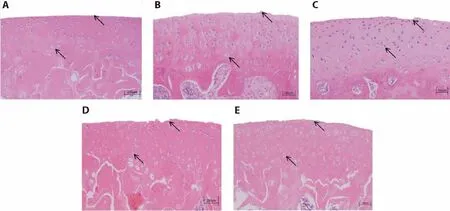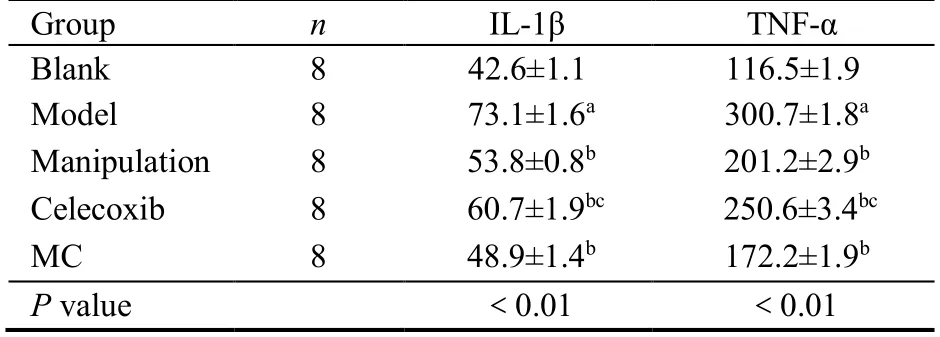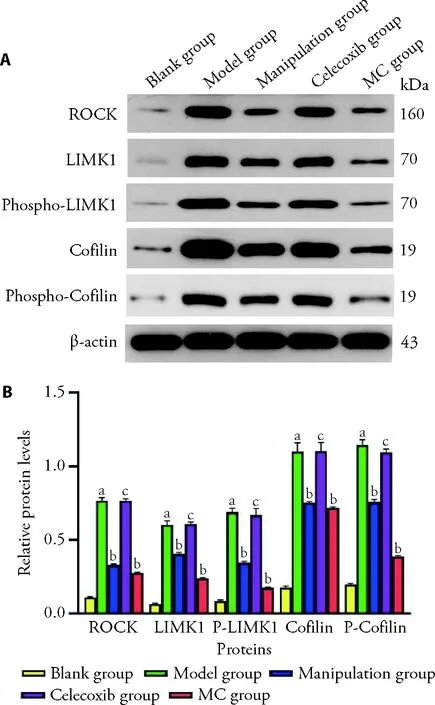Effect of manipulation on cartilage in rats with knee osteoarthritis based on the Rho-associated protein kinase/LIM kinase 1/Cofilin signaling pathways
2022-07-28GUOXiaoYANGYunhaoLIAODongmeiPANGFangYANGZhixueZHUZhengweiLUOAoTANGChenglin
GUO Xiao,YANG Yunhao,LIAO Dongmei,PANG Fang,YANG Zhixue,ZHU Zhengwei,LUO Ao,TANG Chenglin
GUO Xiao,YANG Yunhao,LIAO Dongmei,PANG Fang,YANG Zhixue,ZHU Zhengwei,LUO Ao,TANG Chenglin,College of Traditional Chinese Medicine,Chongqing Medical University,Chongqing 400010,China Beibei Traditional Chinese Medicine Hospital,Chongqing 400700,China
Abstract OBJECTIVE:To investigate the effect of manipulation treatment on knee osteoarthritis rats and the effect on Rho-associated protein kinase (ROCK)/LIM-kinase1(LIMK1)/Cofilin signaling pathway.METHOD:Fifty Specific pathogen Free Sprague-Dawley rats were randomly divided into five groups (n=8 each):blank group,model group,manipulation group,celecoxib group,and manipulation combined with celecoxib group(MC group).The osteoarthritis model was established by injecting 0.2 mL 4% papain into the articular disc of the rats.After successfully establishing the model,we treated the manipulation group with pushing manipulation using one-finger-meditation to the Neixiyan (EX-LE4),Waixiyan(EX-LE5),Xuehai (SP10),Liangqiu (ST34),and Zusanli(ST36) acupoints for 10 min each time.Also,the celecoxib group was gavaged with 24 mg •kg-1 •d-1 celecoxib,while the MC group was treated using both of these two methods.After four weeks,the cartilage of the right femur was removed for hematoxylin-eosin staining of the cartilage tissue.The expressions of interleukin-1β(IL-1β) and tumor necrosis factor-α (TNF-α) in serum were observed using the enzyme-linked immunosorbent assay.Besides,we detected the expressions of ROCK,LIMK1,Phospho-LIM-kinase1 (Phospho-LIMK1),Cofilin,and Phospho-Cofilin by Western blot.RESULTS:Compared to the model group,the manipulation group,celecoxib group,and MC group all exhibited superior results concerning pathological morphologic changes of cartilage,as observed by hematoxylin-eosin staining and calculated using the Mankin score.Besides,in contrast to the blank group,the model group exhibited elevated serum levels of IL-1β and TNF-α (P < 0.01),while the expression of ROCK,LIMK1,Phospho-LIMK1,Cofilin,and Phospho-Cofilin in cartilage were all higher (P < 0.01).Also,the serum levels of IL-1β and TNF-α in each treatment group were lower (P <0.01)than in the model group.Moreover,there were lower expressions of ROCK,LIMK1,Phospho-LIMK1,Cofilin,and Phospho-Cofilin in cartilage in the manipulation group and the MC group (P <0.01).Compared with the model group,the expression of ROCK,LIMK1,Phospho-LIMK1,Cofilin,and Phospho-Cofilin in cartilage in the celecoxib group were not statistically different (P >0.05).CONCLUSION:In this study,we established that manipulation has a better curative effect than celecoxib.Manipulation inhibits the development of cytoskeleton damage in cartilage and slows articular degeneration by regulating the expression of related proteins in the cytoskeletal signaling pathway.
Keywords:osteoarthritis,knee;manipulation;cytoskeletal proteins;Rho-associated kinases;LIM kinases;actin depolymerizing factors;signal transduction
1.INTRODUCTION
Knee osteoarthritis (KOA) is a common disease in middle-aged and elderly people that has a serious impact on their quality of life.Characterized by degenerative changes in articular cartilage,KOA is an osteoarthritic disease that mainly manifests clinically as joint pain,stiffness,swelling,deformity,and functional impairment.1Surveys have shown that the prevalence rate of KOA in people over 60 years old in China is about 8.1%.2With an increasingly aging population,KOA will soon bring an even greater burden to society.Current clinical studies have proven that manipulation can effectively prevent and treat knee osteoarthritis,3,4but its mechanism is not yet clear.
The pathological mechanism of KOA is complex,and related studies have demonstrated that when chondrocytes are subjected to certain physical or chemical stimuli,the cytoskeleton can be disrupted through upregulation of the ROCK/LIMK1/Cofilin skeletal signaling pathway,leading to degenerative changes in the articular cartilage.5,6In this experiment,we observed the expression of key proteins in the ROCK/LIMK1/Cofilin skeletal signaling regulatory pathway in the cartilage of rats with knee osteoarthritis to explore the mechanism of Tuina treatment for knee osteoarthritis.
2.MATERIALS AND METHODS
2.1.Animals
Fifty 3-month-old Specific pathogen Free male Sprague-Dawley rats weighing between 300 and 400 g were purchased from the Experimental Animal Center of Chongqing Medical University,Chongqing,China(number of qualitative qualification:0017852).They were housed in the animal facility with free access to standard rat chow and water on a 12 h light/dark cycle.Experiments were conducted after one week of adaptive feeding.The Institutional Animal Care and Use Committee of Chongqing Medical University,Chongqing,China approved all of the animal experiments.
2.2.Materials
The following materials were used during the experiments:Papain (G8430,Beijing,China Solabao);IL-1β ELISA kit (CRE0006,Beijing,China 4A Biotech);TNF-α ELISA kit (CRE0003,Beijing,China 4A Biotech);ROCK primary antibody (4035T,CST,Danvers,MA,USA);LIMK1 primary antibody(BS2775R,Beijing,China Boaozen);Cofilin primary antibody (5175T,CST,Danvers,MA,USA);Phospho-LIMK1 primary antibody (AF3345,Affinity,Cincinnati,OH,USA);Phospho-Cofilin primary antibody (3313T,CST,Danvers,MA,USA);β-actin primary antibody(4970T,CST,Danvers,MA,USA);protein-free rapid blocking solution (PS108,Shanghai,China Epizyme Biomedical Technology);secondary antibody (EarthOx,Millbrae,CA,USA);ECL luminescent solution (4A Biotech,Beijing,China).
The following equipment was also used:flexible film pressure sensor (MY2801,Shanghai,China Chengke);cryogenic high-speed centrifuge (SIGMA,Osterode am Harz,Germany);Mini-PROTEIN electrophoresis and transfer system (Bio-Rad,Hercules,CA,USA);paraffin microtome (Leica Instruments,Shanghai,China);BX53 orthomosaic microscope (Olympus,TKY,Japan);cellSens Standard image acquisition software (Olympus,TKY,Japan).
2.3.Knee osteoarthritis model and group treatments
The fifty rats were randomly divided into five groups,with ten rats in each group:blank group,model group,manipulation group,celecoxib group,and MC group.The model group,manipulation group,celecoxib group,and MC group were injected with 0.2 mL 4% papain into the knee joint on Days 1,4,and 7.Next,we extracted the right tibial plateau cartilage from two rats that were randomly selected from each group and observed the morphological changes by hematoxylin-eosin (HE)staining.The Mankin score was used to determine the success of the model.7
On the first day after the model was successfully established,the rats were treated with manipulation and gavage.In the manipulation group,the rats were secured to the rat fixation equipment and the acupoints were determined by following the principles of acupuncture points inExperimental Acupuncture.8After the rats had become calm,they were treated with pushing manipulation using one-finger meditation to the Neixiyan (EX-LE4),Waixiyan (EX-LE5),Xuehai(SP10),Liangqiu (ST34),and Zusanli (ST36) acupoints.The front of the thumb was precisely touching the acupoints,the film pressure tester was calibrated to a longitudinal pressure of 5 N,and the frequency was controlled at 120 times/min for 2 min per point.Finally,we performed flexion and extension of the joint ten times.This procedure was conducted once daily for six consecutive days,then stopped for one day.The celecoxib group was given 24 mg·kg-1·d-1celecoxib by gavage.The celecoxib was dissolved in saline and prepared as a suspension,according to the interspecies equivalence dose conversion table in Pharmacological Experimental Methodology,and was administered once a day for six days,but not on the seventh day.9In the MC group,the above two treatments were both given.Each group was treated for four consecutive weeks.
After four weeks,the rats were weighed and then anesthetized by intraperitoneal injection of 0.3% sodium pentobarbital (30 mg/kg).After anesthesia,the right femur was removed and placed in paraformaldehyde for 24 h,then decalcified in 10% Ethylene Diamine Tetraacetic Acid decalcification solution,which was replaced once a day.After the femur became soft,it was dehydrated and embedded,then the cartilage of the right tibial plateau was extracted,placed in a tank of liquid nitrogen,and refrigerated at-80 ℃ for further analysis.Blood from the abdominal aorta was left at room temperature for 1 h,then the serum was collected after centrifugation at 3500 r/min for 15 min and stored at-80 ℃ for subsequent analysis.
2.4.Hematoxylin-eosin (HE) staining of cartilage tissue
After decalcification was complete,the samples were dehydrated and embedded in paraffin,then cut into slices.Images were obtained and analyzed under light microscopy.We referred to the Mankin OA histological grading scale for scoring.
2.5.Measurement of serum IL-1β and TNF-α levels by enzyme-linked immunosorbent assay (ELISA)
The serum levels of IL-1β and TNF-α were measured by ELISA,according to manufacturer protocol.ELISA kits(210407B6 and 210407O4) were purchased from Jiangsu Jing Mei Biological Technology Co.,Ltd.(Jiangsu,China).
2.6.Measurement of LIMK1,phospho-LIMK1,cofilin,and phospho-cofilin levels by Western Blot
Total protein was extracted from the rat cartilage tissue using radioimmunoprecipitation assay (RIPA) buffer containing phosphatase inhibitor cocktail.Western blots were performed using 12% SDS-PAGE gels.Next,proteins were transferred to a nitrocellulose transfer membrane.The membrane was blocked with a fast blocking solution at room temperature for 15 min,then incubated with the primary antibodies at 4 ℃ overnight.The primary antibodies included anti-ROCK,anti-LIMK1,anti-Phospho-LIMK1,anti-Cofilin,anti-Phospho-Cofilin,and anti-β-actin.The membranes were incubated with secondary antibodies at room temperature for 1 h.ECL chemiluminescent solution was added dropwise and the samples were subjected to darkroom exposure for 1 min.We used the Image Studio imaging system to capture the images,then uesed the Image J program to calculate the expression levels of the various substances.
2.7.Statistical analysis
The results in this study were presented as the mean ±standard deviation () and evaluated using one-way analysis of variance with Tukey multiple comparison test(IBM SPSS 22.0,Armonk,NY,USA;GraphPad Prism 9,San Diego,CA,USA).ThePvalue less than 0.05 was considered to be statistically significant.
3.RESULTS
3.1.Morphological observation of cartilage tissue
Morphological changes of cartilage were assessed using HE staining,as shown in Figure 1.The cartilage of the blank group was structurally intact,with clear HE staining on each bone layer,a smooth surface without fissures,and uniform distribution of chondrocytes without clustering (Figure 1A).In the model group,the cartilage layer was thinner with uneven HE staining,a rough surface with even fissures,uneven arrangement,obvious clustering of chondrocytes,and drifting of tide lines (Figure 1B).The cartilage surface damage in the manipulation group,celecoxib group,and MC group was somewhat subtler than in the model group (Figures 1C-1E),the staining was more uniform,and the chondrocyte clustering phenomenon was significantly reduced.Besides,in the celecoxib group,the clustering of cells was more obvious,the number of chondrocytes was lower,the surface was relatively rough,and the staining was less uniform than in the manipulation group and the MC group (Figure 1D).

Figure 1 Morphological changes in rat knee cartilage (hematoxylin-eosin staining,× 200)
The Mankin’s score for each group showed that the model group (8.8 ± 0.9) scored significantly higher than the blank group (0.4 ± 0.5,P <0.01),thus verifying that the modeling was successful.The Mankin scores of the manipulation group (6.4 ± 0.7),celecoxib group (7.2 ±0.5),and MC group (5.9 ± 0.6) were significantly lower than those of the model group (P <0.01),while the scores of the celecoxib group were higher than those of the manipulation group (P<0.05).
3.2.Serum IL-1β and TNF-α levels
The serum levels of IL-1β and TNF-α in the manipulation group were lower than in the celecoxib group (P<0.05),with the results displayed in Table 1.Besides,the serum levels of IL-1β and TNF-α in the model group were significantly higher,compared with the blank group (P<0.01,<0.01).In contrast with the model group,the manipulation group,celecoxib group,and MC group showed considerably lower levels of IL-1β and TNF-α (P<0.01,<0.01) compared with the manipulation group (Table 1).
Tabel 1 Comparison of the level of serum IL-1β,TNF-α (pg/mL,)

Tabel 1 Comparison of the level of serum IL-1β,TNF-α (pg/mL,)
Notes:the Blank group did not undergo any treatment;the Model group were injected with 4% papain 0.2 mL into the knee joint on days 1,4 and 7 ;the Manipulation group were treat with manipulation once daily for six consecutive days,then stopped for one day ;the celecoxib group was given 24 mg•kg-1•d-1 celecoxib by gavageonce daily for six consecutive days,then stopped for one day;the Manipulation combined with Celecoxib group,the above 2 treatments were given once daily for six consecutive days,then stopped for one day.Each group was treated for 4 consecutive weeks.IL-1β:interleukin-1β;TNF-α:tumor necrosis factor-α.Compared with the blank group,aP < 0.01;compared with the model group,bP < 0.01;compared with the manipulation group,cP < 0.05.
3.3.Western blot detection of ROCK,LIMK1,phospho-LIMK1,cofilin,and phospho-cofilin protein expression in cartilage
The expression levels of the ROCK,LIMK1,phospho-LIMK1,cofilin,and phospho-cofilin proteins were significantly higher in the cartilage tissue of rats in the model group,compared with the blank group (P <0.01).However,the expression of all of these proteins in the cartilage tissue of rats in the manipulation group and the MC group was considerably lower than the model group(P<0.01).Besides,there was no statistical significance in the celecoxib group,compared to the model group (P>0.05) (Figure 2).

Figure 2 ROCK,LIMK1,Phospho-LIMK1,Cofilin,and Phospho-Cofilin protein expression in the cartilage tissue of rats in each group detected by Western blot
4.DISCUSSION
Knee osteoarthritis is a chronic joint disease caused by several factors,and related studies have shown that the destruction of the cartilage cytoskeleton is one of the primary elements that lead to degenerative changes in articular cartilage.10The cytoskeleton consists of microfilaments,microtubules,and intermediate fibers,which are fibrillar proteins that maintain the normal morphology and function of cells.The main components of microfilaments are globular actin (G-actin) and fibrous actin (F-actin).Both G-actin and F-actin are interconverted to form an equilibrium,and when the process of F-actin depolymerization to form G-actin is inhibited,cytoskeletal rearrangement occurs,which subsequently causes cytoskeletal disruption.Recent studies have revealed that chondrocytes stimulated by certain physicochemical factors activate the ROCK/LIMK1/Cofilin skeletal signaling regulatory pathways,which can then alter the morphology and spatial location of skeletal fibers within the cell,thus causing cytoskeletal disruption and ultimately leading to impaired normal chondrocyte function.11,12When chondrocytes are activated by physical or chemical stimuli,ROCK phosphorylates LIMK1 to form active Phospho-LIMK1.This consequently phosphorylates Cofilin,inactivating it and thereby inhibiting the function of the Cofilin protein to depolymerize F-actin.As a result,actin undergoes rearrangement,which causes cytoskeletal disruption.Inflammatory factors are closely related to the development of KOA.Interleukins are produced by a variety of cells and are a factor in several diseases,regulating the expression of cartilage and synovial membranes.Cartilage and synovial damage in KOA may be associated with the abnormal regulation of interleukins.13Besides,IL-1β is a pro-inflammatory factor that stimulates inflammation and plays an important role in the development of knee osteoarthritis.14Also,TNF-α is associated with the development of several diseases and is closely related to synovitic lesions and cartilage degeneration in KOA.15Therefore,the combination of levels of inflammatory factors and Mankin’s score allows us to evaluate the efficacy of each type of treatment in a comprehensive manner.
According to Traditional Chinese Medicine,KOA belongs to the categories of “Bone Bi-disease” and “Bidisease”,16and is caused by c ongenital deficiencies,old age,deficiencies in kidneyYang,and deficiencies in the liver and spleen.Additionally,wind,cold,and dampness penetrate into the joints,while falls and impact injuries lead to localQiand blood stagnation and blockages of the meridians and channels.Therefore,the classification of this condition is generally eitherYangdeficiency with congealing cold orQistagnation with blood stasis.17Accordingly,the Traditional Chinese Medical treatment of KOA emphasizes the principles of “tonifying the liver and kidney,invigorating blood circulation to remove blood stasis,warming the main and collateral channels,strengthening the tendons and bones,and dispelling wind and cold”.Most clinical Chinese and Western medical practitioners apply non-steroidal anti-inflammatory drugs (NSAIDs) for treatment,among which celecoxib is the most common.Although NSAIDs provide satisfactory therapeutic outcomes,there are often adverse effects on the liver and kidney,and especially the gastrointestinal tract.18The Suwen-Blood,Qi,Shape and Spirit Chapter states:“The disease is born from unkindness,and the treatment is based on manipulation and mash medicine.” Wang Bing commented that,“Manipulation,open the occlusion,guideYinandYang.”This means that manipulation has the function of unblocking the main and collateral channels and balancingYinandYang,which can make theQiand blood flow smoothly.This helps to moisten the organs,limbs,and bones,thus treating diseases of paralysis.Manipulation therapy can stimulate acupuncture points or painful points to unblock the meridians,activate the blood,regulate the tendons,and smooth the joints.Moreover,appropriate passive movement techniques can play a role in loosening adhesion and slipping joints.19In Chinese medicine,pushing manipulation with one-finger meditation is the primary technique of one-finger meditation,which is widely used in the treatment of knee diseases such as knee osteoarthritis and anterior cruciate ligament injuries.20Huet al21discovered that pushing manipulation with one-finger meditation could effectively reduce knee pain in patients with osteoarthritis of the knee joint.In this experiment,we applied the one-finger meditation pushing method to five acupoints commonly used in the clinical treatment of knee osteoarthritis in rats,including Neixiyan (EX-LE4),Waixiyan (EX-LE5),Xuehai (SP10),Liangqiu (ST34),and Zusanli (ST36),together with the joint flexion and extension method,to achieve the aim of soothing tendons and bones and relieving joint pain.
In this study,both the Mankin score and the serum levels of TNF-α and IL-1β were lower in all treatment groups,compared to the model group.Besides,the manipulation group exhibited lower Mankin scores and serum levels of TNF-α and IL-1β than the celecoxib group.Compared with the model group,ROCK,Cofilin,and LIMK1 protein expression levels in cartilage tissue of the manipulation and the MC groups were lower,and the phosphorylation of Cofilin and LIMK1 also decreased.Conversely,in the celecoxib group,levels of ROCK,Cofilin,and LIMK1 protein expression and phosphorylation did not present significant differences.Therefore,we propose that manipulation is more effective than celecoxib in treating KOA,as it can effectively inhibit the expression of the ROCK/LIMK1/Cofilin spinal signaling regulatory pathway.In contrast,celecoxib does not have an influence on this pathway in treating KOA.Compared with the manipulation group,the MC group was more effective in inhibiting the expression and phosphorylation of ROCK,LIMK1,and Cofilin proteins,indicating that a combination of manipulation and celecoxib can more successfully inhibit the expression of the ROCK/LIMK1/Cofilin skeleton signaling regulatory pathway.
In conclusion,manipulation reduces the impaired cell function caused by chondrocyte skeletal rearrangement by inhibiting the expression of ROCK,LIMK1,and Cofilin proteins and the phosphorylation of LIMK1 and Cofilin,which in turn inhibits the degeneration of cartilage tissue and ultimately achieves the goal of preventing or treating KOA.However,the mechanism by which the combination of celecoxib and manipulation more effectively moderates the expression of the ROCK/LIMK1/Cofilin skeletal signaling regulatory pathway requires further study.We believe that manipulation can be used as an economical,non-invasive,and long-term non-pharmacological therapy for the prevention and treatment of KOA.
杂志排行
Journal of Traditional Chinese Medicine的其它文章
- Acupoint application therapies for essential hypertension:a systematic review and Meta-analysis
- Biosynthesis of titanium dioxide nanoparticles using Hypericum perforatum and Origanum vulgare extracts and their main components,hypericin and carvacrol as promising antibacterial agents
- Protective effect of resveratrol on rat cardiomyocyte H9C2 cells injured by hypoxia/reoxygenation by regulating mitochondrial autophagy via PTEN-induced putative kinase protein 1/Parkinson disease protein 2 signaling pathway
- Efficacy of aqueous extract of flower of Edgeworthia gardneri (Wall.)Meisn on glucose and lipid metabolism in KK/Upj-Ay/J mice
- Baicalin inhibits inflammation of lipopolysaccharide-induced acute lung injury via toll like receptor-4/myeloid differentiation primary response 88/nuclear factor-kappa B signaling pathway
- Modified Gexiazhuyu decoction (膈下逐瘀汤加减方) alleviates chronic salpingitis via p38 signaling pathway
